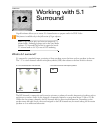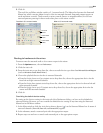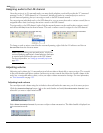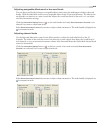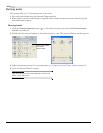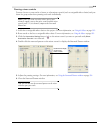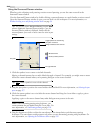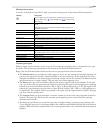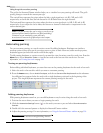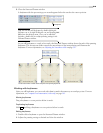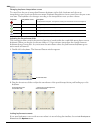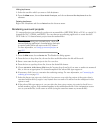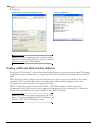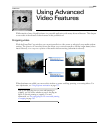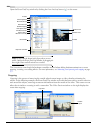
CHP. 12 WORKING WITH 5.1 SURROUND
217
Moving the pan point
A variety of methods are provided to help you position the pan point in the Surround Panner window.
Choosing pan types
When you pan a track or mixer control, you can choose among several pan types to determine how to pan
the audio. The current pan type appears at the bottom of the Surround Panner window.
Right-click the Surround Panner window and choose a pan type from the shortcut menu.
•The Add Channels pan type makes the audio appear to move as a unit among the surround channels. As
you move the pan point toward a channel (speaker icon), more and more of the signal from the other
channels are folded into the channel you are panning towards, until at the extreme, all channels are fed
at full intensity into a single channel. This pan type uses a linear panning curve.
•The Balance pan type is most useful for adjusting the relative signal levels of the channels. In this pan
type, as you move the pan point from the center to a channel, the signal in the channel you are panning
towards starts at the base dB level (either 0 dB, -3 dB, or -6 dB) and increases to 0 dB. The signal in the
channel you are panning away from starts at a base dB level (either 0 dB, -3 dB, or -6 dB) and decays to
no signal level. For example, when you pan fully to the right, only the right channel is audible. This pan
type uses a linear panning curve.
•The Constant Power pan type maintains a constant volume as you move the pan point from channel to
channel. This pan type, which uses the constant-power panning curve, is most useful for panning
monaural source media.
•The Film pan type allows you to pan between pairs of speakers using a constant-power panning curve.
As you drag the pan point to the center speaker, the sound becomes diffused through the front and rear
speakers. When the track is panned fully to the center speaker, there is no sound from the front and rear
speakers.
Method Description
Click to toggle through three options for constraining pan point motion as
you drag: Move Freely (
), Move Left/Right Only ( ), and Move Front/
Back Only (
).
Double-click Double-clicking the pan point resets it to the center front of the surround
panner.
Double-clicking in the Surround Panner window moves the pan point to
the double-click location.
Ctrl+drag Makes fine adjustments.
Shift+drag Constrain m.otion to a line through the center of the surround panner
Alt+drag Constrains motion to a constant radius from the center of the surround
panner.
Shift+Alt+drag Constrains motion to the maximally inscribed circle (a constant radius at
the greatest possible distance from the center of the surround panner).
Arrow keys Moves front/back/left/right.
Ctrl+Arrow keys Makes fine adjustments.
Page Up/Page Down Moves front/back.
Shift+Page Up/Page Down Moves left/right.
Numeric keypad 1-9 Jumps to a corner, edge, or center of the surround panner.
Ctrl+Numeric keypad 1,3,7, 9 Jumps to a location on the maximally inscribed circle (a constant radius at
the greatest possible distance from the center of the surround panner).
Mouse wheel Moves front/back.
Shift+mouse wheel Moves left/right.
Ctrl+mouse wheel Makes fine front/back adjustments.
Ctrl+Shift+mouse wheel Makes fine left/right adjustments.



